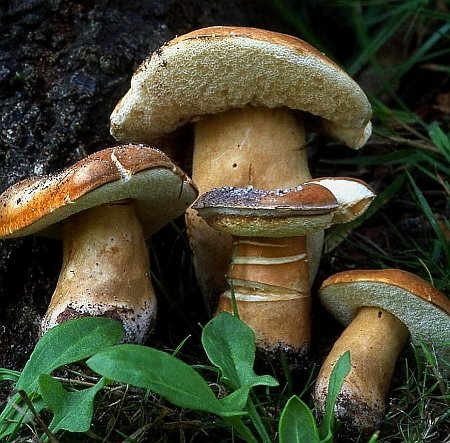The chestnut bolete, Gyroporus castaneus (Bull.) Quél.
Synonyms
Boletus castaneus Bull.
Herbier de la France 7: tab. 328 (1788) [1787-88]
Boletus fulvidus Fr.
Observ. mycol. (Havniae) 2: 247 (1818)
Leucobolites castaneus (Bull.) Beck
Z. Pilzk. 2: 142 (1923)
Leucobolites fulvidus (Fr.) Beck
Z. Pilzk. 2: 142 (1923)
Common names
Chestnut bolete
Kastanie-rørhat (Danish)
Fahler Röhrling (German)
Kuriiro-iguchi (Japanese)
Description
Cap: 3-7 cm diameter, convex when young, becoming broadly convex to plano-convex to plane or depressed in age; surface dry, glabrous to finely tomentose to pulverulent, often rimose with age, colored brown to tan to pinkish brown; margin entire, but becoming rimose or split, involute, becoming inflexed or flared. Context: 5-7 mm thick, white, unchanging when exposed.
Tubes: 3-6 mm deep, 1-3 per mm, shallow to deeply and broadly depressed around the stem, white when young, becoming yellow at maturity, unchanging or darkening slightly when bruised; pores one to two per millimeter, angular, radially elongate near stem apex, concolorous with tubes.
Stem: 2-4 cm long, 0.5-2 cm thick at the apex, equal to tapering toward the apex, hollow in basal portion; surface dry, unpolished, glabrous to tomentose to velutinous, colored similarly to the cap-tan to brown to pinkish brown; context white, unchanging.
Odor: not distinctive.
Taste: mild, slightly acidic.
Spore print: yellow.
Spores: ellipsoid, hyaline to pale yellow in KOH, ochraceous in Melzer’s, nonamyloid, smooth, thin-walled, 8-12 X 5-6 µm.
Edibility: edible and choice.
Habitat: solitary or gregarious under oaks in other hardwoods, during rainy periods in the summer and early fall. According to Arora (1986, pg. 510), it is common in Europe and eastern (but not western) North America.
The in vitro fruit-body production of the strain Bo1, a morphologically similar species to G. castaneus, has been reported (Ohta and Fujiwara, 2003).
Biochemistry
The organic acids composition in the chestnut bolete has been determined to be ~5 g/kg, comprised predominantly of malic acid (74%) and citric plus ketoglutaric acids (24% and 1%, respectively) (Valentao et al., 2005).
Bioactive compounds
Extracts from G. castaneus have shown B-, O-specific human blood group specific hemagglutination (Yagi et al., 2000).
Medicinal properties
Anti-tumor effects
Polysaccharides extracted from the mycelial culture of G. castaneus and administered intraperitoneally into white mice at a dosage of 300 mg/kg inhibited the growth of Sarcoma 180 and Ehrlich solid cancers by 80% and 70%, respectively (Ohtsuka et al., 1973).

My name is Austin Collins.
I've dedicated my life to Mushrooms.
I believe Mushrooms are the best kept secret when it comes to health and well being.
For that reason, I would like to share a company with you that in my opinion makes the best mushroom products on the market.
The company is called Noomadic Herbals, my favorite supplement they make is called "Mushroom Total".
I take their products every day and they have helped me think better and have more energy. Give them a try.
-Austin
Links
References
Arora D. (1986).
Mushrooms demystified.
Berkeley: Ten speed press. (959 pp)
Baroni TJ.
Chemical spot test reactions boletes.
Mycologia. 1978 70(5):1064-76.
Heinemann P, Rammeloo J.
Observations on Gyropus castaneus.
Bulletin du Jardin Botanique National de Belgique. 1979 49(3-4):435-48.
Ohta A, Fujiwara N.
Fruit-body production of an ectomycorrhizal fungus in genus Boletus in pure culture.
Mycoscience. 2003 44(4):295-300.
Ohtsuka S, Ueno S, Yoshikumi C, Hirose F, Ohmura Y, Wada T, Fujii T, Takahashi E.
Polysaccharides having an anticarcinogenic effect and a method of producing them from species of Basidiomycetes.
UK Patent 1331513, 26 September 1973.
Smith AH. (1971).
The boletes of Michigan, by Alexander H. Smith and Harry D. Thiers.
University of Michigan Herbarium Fungus Monographs.
Online
Valentao P, Lopes G, Valente M, Barbosa P, Andrade PB, Silva BM, Baptista P, Seabra RM.
Quantitation of nine organic acids in wild mushrooms.
J Agric Food Chem. 2005 53(9):3626-30.
Yagi F, Sakai T, Shiraishi N, Yotsumoto M, Mukoyoshi R.
Hemagglutinins (lectins) in fruit bodies of Japanese higher fungi.
Mycoscience. 2000 41(4):323-30.



